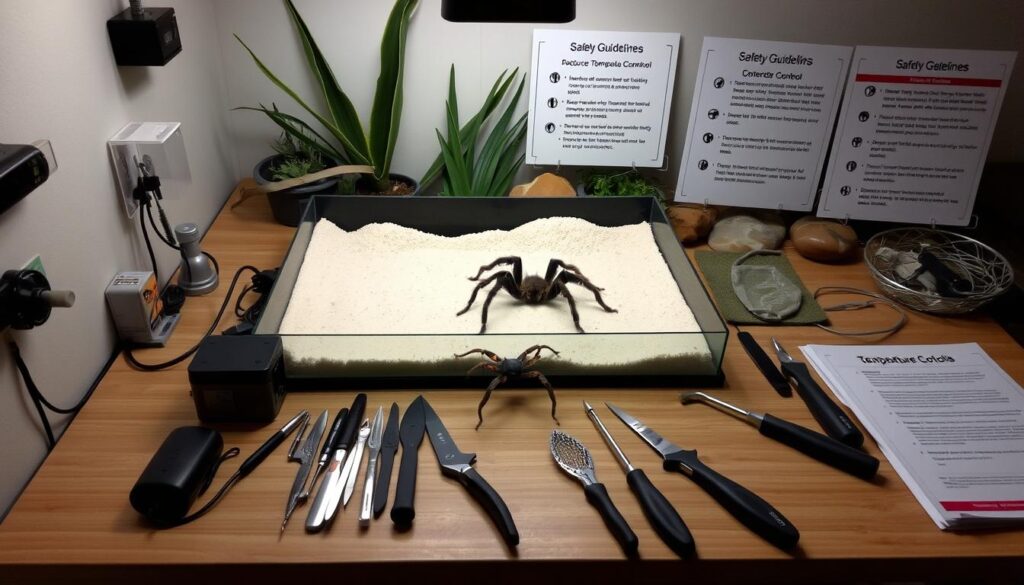How to Safely Handle a Tarantula

Tarantulas are fascinating arachnids that have become popular pets. Handling them requires careful thought and the right techniques for safety. This guide will give you the knowledge and skills to handle a tarantula safely and with confidence.
Owning a tarantula is exciting and rewarding, but it’s important to know their unique behaviors and care needs. By learning how to handle tarantulas well, you can enjoy your pet’s beauty and curiosity safely. We’ll cover tarantula care, tarantula husbandry, and how to handle tarantulas with ease in the next sections.
Understanding Tarantula Behavior
Tarantulas are fascinating, but knowing how they act is key to handling them safely. They can be calm or defensive. It’s important to know when they might get aggressive to avoid bites and keep interactions positive.
Recognizing Signs of Aggression
Tarantulas show aggression in different ways, like raising their front legs or hissing. These signs mean they feel threatened and are ready to defend themselves. It’s crucial to pay attention to these signals to keep everyone safe.
Tarantula Defense Mechanisms
Tarantulas have ways to protect themselves, like flicking urticating hairs. This can bother anyone who touches them. They might also stand up or bite if they feel threatened. This shows why we must be careful and respectful around them.

Learning about tarantula behavior and defense is important for those who love these spiders. By knowing when they might get aggressive and respecting their defenses, you can have a safe and fun time with them.
Preparing the Handling Environment
Before you handle a tarantula, make sure your environment is ready. A tarantula handling station with a secure, non-slip surface is key. It helps prevent the tarantula from escaping or getting stressed.
Setting Up a Tarantula Handling Station
Create a tarantula handling environment in your home or workspace. Pick a sturdy, flat surface big enough for the tarantula’s size. Make sure it’s non-slip, like a wooden table or a tray with a towel or fabric on it.
Keep these items close in your handling area:
- A container or jar with a secure lid to transfer the tarantula if needed
- Long-handled tongs or forceps to assist with handling the tarantula
- A thick, sturdy glove to protect your hand in case of unexpected behavior
- A damp paper towel or small water dish to mist the tarantula’s environment
With a well-organized and tarantula-friendly station, handling tarantulas will be safe and stress-free for both you and the tarantula.

Essential Tarantula Handling Techniques
Handling a tarantula safely means being gentle and understanding their behavior. It’s important to know how to handle them to keep both the tarantula and the handler safe.
Begin by carefully placing the tarantula on your hand. Don’t make sudden moves that might scare it. Let the tarantula rest on your palm, supporting its body evenly. Move slowly and don’t press too hard on its legs or belly.
- Approach the tarantula with a calm and confident demeanor.
- Extend your hand, palm facing upwards, and gently guide the tarantula onto your hand.
- Ensure the tarantula’s body weight is evenly distributed across your palm.
- Avoid sudden movements or actions that may startle the arachnid.
- Maintain a slow and deliberate pace throughout the handling process.
Remember, the tarantula’s safety is key. Learning these handling techniques helps you have safe and enjoyable times with these amazing creatures.
| Technique | Description | Benefits |
|---|---|---|
| Gentle Guidance | Slowly and carefully directing the tarantula onto your hand. | Minimizes stress and the risk of startling the arachnid. |
| Balanced Support | Evenly distributing the tarantula’s weight across your palm. | Ensures the tarantula’s comfort and stability during handling. |
| Deliberate Movements | Moving at a slow and controlled pace throughout the process. | Prevents sudden actions that could alarm the tarantula. |
By learning these tarantula handling techniques, you can safely and confidently interact with these fascinating arachnids. This helps you appreciate their unique traits and behaviors more.
Tarantula Species and Their Temperaments
There are many tarantula species, each with its own temperament and needs. As a tarantula enthusiast, knowing about these differences is important. It helps ensure a safe and fun experience with these creatures.
 Building a Tarantula Terrarium
Building a Tarantula Terrarium
Docile Tarantula Species for Beginners
For beginners, some tarantulas are easier to handle because they are gentle. These are great for new owners because they don’t get easily upset. The Brachypelma smithi (Mexican Red-Knee Tarantula), Aphonopelma chalcodes (Arizona Blonde Tarantula), and Grammostola rosea (Chilean Rose Tarantula) are good choices.
More Aggressive Tarantula Species
Some tarantulas are calmer and easier to handle, but others can be more aggressive. These may defend themselves by showing off, flicking hairs, or even biting. The Poecilotheria regalis (Ornamental Tree Tarantula), Theraphosa blondi (Goliath Birdeater), and Haplopelma lividum (Cobalt Blue Tarantula) are examples of these aggressive types. They need more care and experience when handled.
Always be careful and respectful when handling tarantulas, no matter the species. Doing your homework, preparing well, and understanding their behavior is crucial. This ensures a safe and positive experience for you and your tarantula.
Tarantula Enclosure Setup and Maintenance
Creating a great tarantula enclosure is key for your pet’s health. Think about what your tarantula needs, like the right temperature, humidity, and substrate.
Begin with a tank that’s big enough for your tarantula, like a 5-10 gallon one for the Texas Brown Tarantula. Make sure the substrate is 5-8 inches deep for burrowing. Use a special tarantula substrate with a pH of 6.5 to 7.5.
Add places for your tarantula to hide, like cork bark or rocks. Keep the temperature at 72-84°F and the humidity right to avoid breathing problems.
- Regularly mist the enclosure to keep humidity levels correct.
- Check the tarantula enclosure setup often and adjust as needed for the best conditions.
- Do tarantula enclosure maintenance by cleaning spots and removing uneaten food to stop mold or bacteria.
Good tarantula enclosure maintenance is vital for your pet’s health. A secure and comfy home lets your tarantula live its best life.
Feeding Your Tarantula
Feeding your tarantula right is key to their health. These creatures eat meat and need a balanced diet. Knowing what and how much to feed them keeps them happy and healthy.
What to Feed a Tarantula
Tarantulas eat a variety of foods. Common foods include:
- Crickets
- Mealworms
- Roaches
- Small mice or rats (for larger tarantulas)
Make sure the food is the right size for your tarantula. It should be small enough for them to easily eat. Don’t give them prey that’s too big, as it could choke them.
Some tarantula owners also give waxworms or fruit flies as treats. But, don’t give these too often. They are high in fat and can make your tarantula overweight.
When feeding your tarantula, do it carefully. Watch how they react to the food. Some tarantulas might be slow to eat or even get upset. Be careful to avoid bites or stress.
Handling Tarantula Molting
Tarantulas go through a process called molting, where they shed their skin for growth. This is a sensitive time for them, needing special care. It’s important for tarantula lovers to know how to handle this phase for their pet’s health.
When a tarantula molts, it’s key to keep the area calm and quiet. Handling a tarantula during this time should be avoided to prevent harm. Watch from afar, making sure the tarantula’s space stays calm until it has fully shed its skin.
After molting, don’t touch the tarantula for a few days to let its new skin harden. This keeps the tarantula safe and stress-free. Once it’s strong again, you can start handling it gently, but be very careful.
Dealing with a molting tarantula needs a gentle touch and knowledge of their needs. By understanding and respecting their molting, you help keep your tarantula healthy and safe during this important time.
handling tarantula
Handling a tarantula can be exciting and educational. But, it needs patience, caution, and the right approach. It’s key to know the proper techniques and risks when handling these fascinating arachnids.
 Tarantula Feeding: Insects and Prey
Tarantula Feeding: Insects and Prey
When handling a tarantula, remember to move slowly and deliberately. Sudden moves or loud sounds can scare the tarantula and make it defensive. Approach the enclosure calmly and use gentle, controlled motions when moving the tarantula from its home to your hand.
It’s vital to maintain a secure grip on the tarantula. Hold the abdomen firmly but not too tight, and support the legs and body. This prevents the tarantula from slipping or falling. Don’t hold the tarantula by its legs as it can get hurt.
- Prepare the handling area: Make sure the surface is smooth, clean, and free of objects that could harm the tarantula if it falls.
- Remain calm and patient: Tarantulas can sense your emotions. A relaxed, confident attitude will make handling easier.
- Avoid sudden movements: Slow, careful actions will keep the tarantula calm and lower the chance of a defensive reaction.
- Support the tarantula’s body: Use your hand to gently cradle the abdomen and legs, giving a secure and comfy grip.
- Keep the tarantula close to the ground: If the tarantula gets away, this will reduce the risk of injury.
Remember, handling a tarantula is a privilege, not a right. Always put the tarantula’s safety and well-being first. Don’t handle one if you’re not sure you can do it safely. With patience, practice, and respect for these amazing creatures, you can enjoy the thrill of handling a tarantula and learn more about the natural world.
Tarantula Safety Precautions
Handling tarantulas safely is key to preventing accidents and keeping both you and the spider safe. It’s important to understand the tarantula safety aspects. These spiders have unique ways to defend themselves that can be risky if not handled right.
Preventing Escape and Bites
To avoid a tarantula escape or a potential bite, follow these steps:
- Make sure the tarantula’s enclosure has a tight-fitting lid or cover so it can’t get out or push through.
- Don’t touch the tarantula when it’s most likely to be defensive, like when it’s molting, eating, or showing aggression.
- Be careful when cleaning the enclosure, keeping an eye on the tarantula and using tools or barriers to stop it from escaping.
- Learn about the behavior and nature of the tarantula you have, as some might be more likely to bite or act defensively.
- Have a plan ready for catching a tarantula if it gets out, including the right tools and a safe place for the catch.
Following these tarantula safety precautions greatly lowers the risks of owning these interesting spiders. It makes sure you and your tarantula can enjoy each other’s company safely.
| Tip | Description |
|---|---|
| Secure Enclosure | Make sure your tarantula’s home has a tight lid or cover to stop it from escaping. |
| Avoid Handling During Sensitive Times | Don’t touch your tarantula when it’s molting, eating, or acting aggressive. |
| Know Your Tarantula’s Temperament | Learn about the behavior and nature of your tarantula to understand its risks. |
| Have a Recapture Plan | Be prepared for a tarantula escape by having a safe area and the right tools for catching it. |
Tarantula Husbandry: A Comprehensive Guide
Keeping the right environment is key for your pet tarantula’s health. It’s important to know the temperature and humidity needs for different tarantulas. This guide will help you create the perfect home for your tarantula.
Temperature Requirements for Tarantulas
Tarantulas need their environment to control their body temperature. Most tarantulas like a temperature between 70-85°F (21-29°C). The right temperature helps with their metabolism, eating, and health.
To keep the right temperature, use heaters, lamps, or space heaters. Make sure the size of the enclosure fits the heating method. Check the temperature often to keep it right for your tarantula.
Humidity Requirements for Tarantulas
Humidity is also key for tarantulas. Most species do well in 60-80% humidity. The right humidity prevents breathing problems, helps with molting, and keeps your tarantula healthy.
To get the right humidity, try these methods:
- Put a water dish or mister in the enclosure
- Add damp substrate or sphagnum moss
- Use a hygrometer to check humidity and adjust as needed
Remember, different tarantulas need different temperatures and humidity levels. Always check the specific needs of your tarantula for the best care.
| Tarantula Species | Temperature Range (°F/°C) | Humidity Range (%) |
|---|---|---|
| Brachypelma smithi (Mexican Red-Knee) | 70-80°F (21-27°C) | 60-70% |
| Grammostola pulchra (Brazilian Black) | 75-85°F (24-29°C) | 65-75% |
| Poecilotheria metallica (Metallic Ornamental) | 75-82°F (24-28°C) | 70-80% |
When to Seek Professional Help
Handling tarantulas can be thrilling, but sometimes you need professional help. It’s key to know when to get advice from a vet or an expert keeper. Your tarantula’s health should always come first.
If your tarantula looks sick or hurt, get help. Signs like not eating, being very tired, or acting strangely could mean it’s sick. Also, if it gets hurt, like from a fall or bite, see a pro to help it heal fast.
- Sudden changes in appetite or lethargy
- Unusual behavior that concerns you
- Physical trauma, such as a fall or bite
Sometimes, your tarantula might need special care you can’t handle. For example, when it’s getting ready to molt, get advice from an expert. Molting is a big deal for tarantulas, and messing it up can be bad.
| Situation | Recommended Action |
|---|---|
| Suspected illness or injury | Consult a veterinarian |
| Specialized care or handling requirements | Seek guidance from an experienced tarantula keeper |
| Concerns about the tarantula’s well-being | Reach out to a professional for advice |
Asking for help with your tarantula shows you care deeply. It’s a sign of your commitment to giving your tarantula the best life. Working with experts helps keep your tarantula healthy and happy, making you a great keeper.
Building Confidence in Tarantula Handling
Handling tarantulas can be scary, especially for beginners. But with patience, practice, and help from experts, you can get better at it. You’ll learn to handle these amazing creatures safely and with ease.
 Exotic Tarantula Species
Exotic Tarantula Species
Start by going slow and learning the basics. Get to know your tarantula’s behavior and how it defends itself. Learn the signs of when it might get aggressive. This will make you feel more confident and calm when you handle it.
Next, create a special area in your home for handling tarantulas. This space should be safe and controlled. Practice handling your tarantula there often, with an expert watching over you. This will help you get better at it and build a strong connection with your pet.



